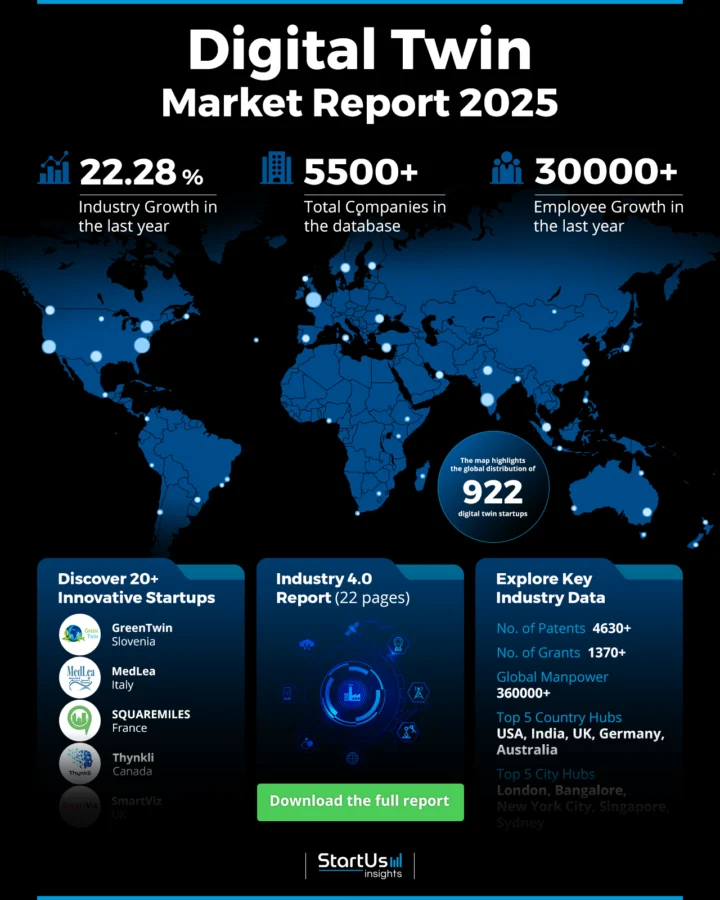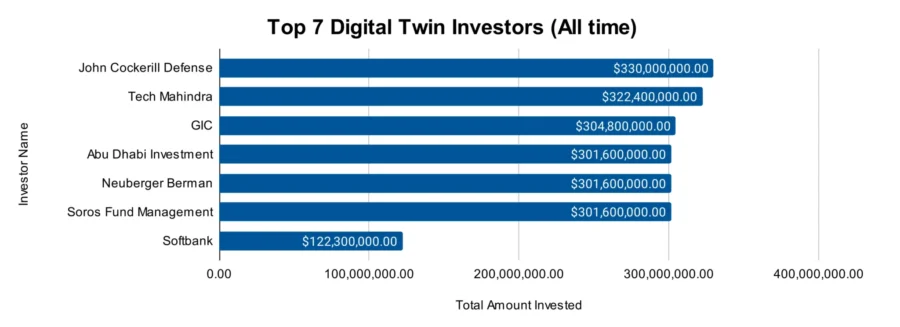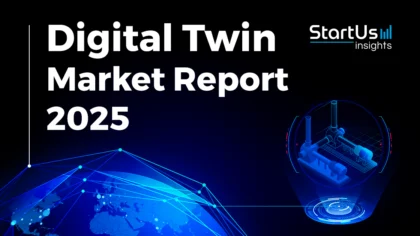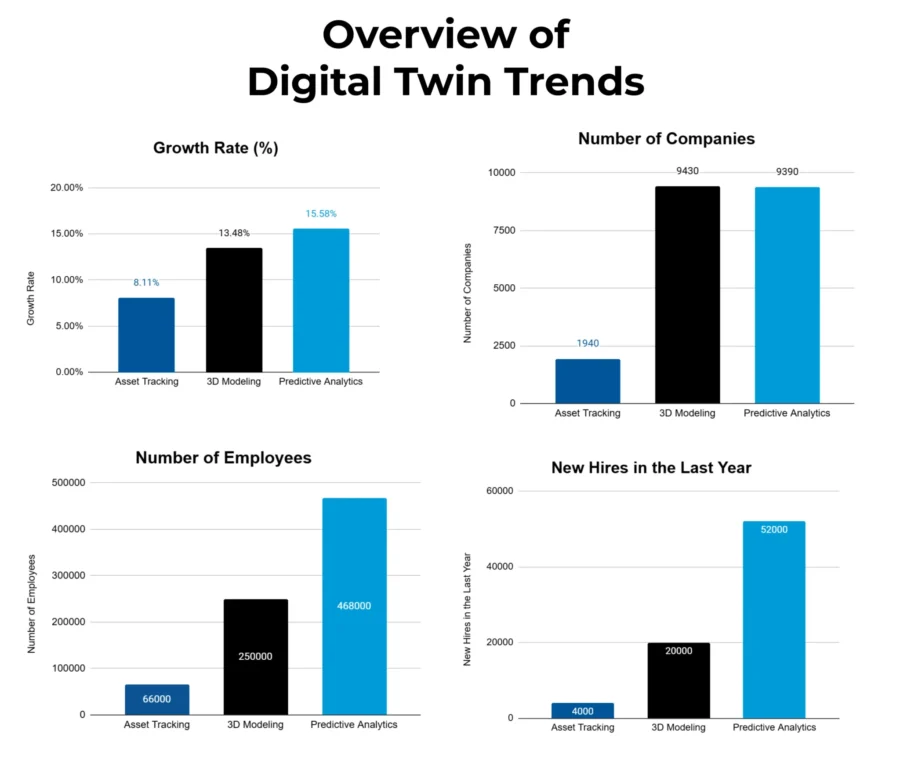Accelerate Productivity in 2025
Reignite Growth Despite the Global Slowdown
The 2025 Digital Twin Market Report highlights the transformative impact of digital twin technology on industries like manufacturing, healthcare, and smart cities, driven by trends in asset tracking, 3D modeling, and predictive analytics. It explores investment opportunities and emerging startups shaping innovation, offering valuable insights for stakeholders to navigate the market’s growth trajectory.
Executive Summary: Digital Twin Market Report 2025
- Industry Growth Overview: The digital twin market size will grow from USD 29.06 billion in 2025 and will grow up to USD 99.2 billion in 2029 at a compound annual growth rate of 35.9%. More than 910 startups are actively contributing to this landscape.
- Manpower & Employment Growth: The market employs over 360K individuals, with an addition of 30K+ new employees in the last year.
- Patents & Grants: The market has secured over 4630 patents and more than 1370 grants. The patent growth rate is 39.23% yearly, with China and the US leading in patent issuance.
- Global Footprint: Key hubs include the USA, India, UK, Germany, and Australia while major city hubs encompass London, Bangalore, New York City, Singapore, and Sydney.
- Investment Landscape: The total funding closed exceeds 4390, with average investment values exceeding USD 9 million per round. More than 3K investors are actively involved.
- Top Investors: Key investors include John Cockerill Defense America, Tech Mahindra, GIC, and more have collectively invested over USD 1.98 trillion.
- Startup Ecosystem: Five innovative startups MedLea (digital twin-led predictive lung health), Green Twin (BIM facility & energy management), SmartViz (building management optimization), SQUAREMILES (urban logistics decarbonization), and Thynkli (digital twin as a service) showcase the market’s global reach and entrepreneurial spirit.

Methodology: How We Created This Digital Twin Market Report
This report is based on proprietary data from our AI-powered StartUs Insights Discovery Platform, which tracks 25 million companies and 20 000 technologies and trends globally, including detailed insights on approximately 5 million startups, scaleups, and tech companies.
Leveraging this extensive database, we provide actionable insights on emerging technologies and market trends.
For this report, we focused on the evolution of digital twins over the past 5 years, utilizing our platform’s trend intelligence feature. Key data points analyzed include:
- Total Companies working on the trend
- News Coverage and Annual Growth
- Market Maturity and Patents
- Global Search Volume & Growth
- Funding Activity and Top Countries
- Subtrends within the digital twin
Our data is refreshed regularly, enabling trend comparisons for deeper insights into their relative impact and importance.
Additionally, we reviewed external resources to supplement our findings with broader market data and predictions, ensuring a reliable and comprehensive overview of the digital twin market.
What Data is Used to Create This Digital Twin Market Report?
Based on the data provided by our Discovery Platform, we observe that the digital twin industry ranks among the top 5% in the following categories relative to all 20K topics in our database.
These categories provide a comprehensive overview of the industry’s key metrics and inform the short-term future direction of the industry.
- News Coverage & Publications: Over 7900 publications have covered digital twin topics in the past year, and this reflects growing interest in the market.
- Funding Rounds: Our database tracks more than 4390 funding rounds, which highlight strong investor confidence in the digital twin market.
- Manpower: The digital twin domain employs more than 360K workers, with an increase of over 30K new employees added in the past year.
- Patents: The market has registered 4630+ patents which indicates a higher focus on innovation and intellectual property (IP) development.
- Grants: More than 1370 grants have been awarded within the digital twin landscape.
- Yearly Global Search Growth: There has been a 26.46% growth in global searches related to digital twins.
Explore the Data-driven Digital Twin Market Report for 2025
According to the Business Research Company, the digital twin market size will grow from USD 29.06 billion in 2025 and will grow up to USD 99.2 billion in 2029 at a compound annual growth rate of 35.9%.
As per Mordor Intelligence, the digital twin market size is estimated at USD 36.19 billion in 2025 and is expected to reach USD 180.28 billion by 2030, at a compound annual growth rate of 37.87% during the forecast period 2025-2030.
Another analysis suggests that the global digital twin market size is estimated to grow from USD 12.8 billion in 2024 to USD 240.3 billion by 2035, growing at a compound annual growth rate of 41% during the forecast period, till 2035.
The digital twin industry outlook 2025 uses data from the Discovery Platform and encapsulates the key metrics that underline the sector’s dynamic growth and innovation.
In the past year, the market experienced a 22.28% growth which indicates an increase in demand and investment.

Credit: The Business Research Company
Moreover, the global workforce in this domain exceeds 360K professionals, with an addition of 30K+ employees in the last year.
The digital twin report also highlights the USA, India, UK, Germany, and Australia as the top five country hubs, while major city hubs include London, Bangalore, New York City, Singapore, and Sydney.
A Snapshot of the Global Digital Twin Industry
The digital twin market demonstrates an annual growth rate of 22.28%. It features 910+ startups actively contributing to innovation, with over 510 early-stage startups and more than 200 mergers and acquisitions (M&A) reported.
In terms of intellectual property, the market has amassed over 4630 patents, with more than 710 applicants involved in this landscape.
The yearly patent growth stands at 39.23% which showcases rapid developments in technology and application development.
Further, China leads as the top issuer of patents, contributing over 2350 patents, followed by the USA with approximately 1200 patents.
Explore the Funding Landscape of the Digital Twin Industry
The average investment value per funding round stands at approximately USD 9 million. The digital twin market has attracted more than 3000 investors which showcases that stakeholders are supporting digital twin technologies.
In total, the digital twin domain has closed over 4390 funding rounds and these investors have targeted more than 1060 companies.

Who is Investing in the Digital Twin Market?
The digital twin market has attracted major investments from various top investors who have collectively contributed over USD 1.98 trillion.

- John Cockerill Defense America has invested USD 330 million in at least 1 company. John Cockerill announced its acquisition of French land vehicle maker Arquus, aiming for an annual turnover of USD 1.1 billion.
- Tech Mahindra invested a total of USD 322.4 million in at least 1 company. Tech Mahindra acquired Orchid Cybertech, a Pune-based telecom customer service provider, for USD 3.27 million.
- GIC has contributed USD 304.8 million across 2 companies. GIC and Silver Lake are acquiring Zuora for USD 1.7 billion at USD 10 per share, with the deal closing in early 2025.
- Abu Dhabi Investment Authority has invested USD 301.6 million in at least 1 company. ADIA invested approximately USD 750 million in the debt of India’s GMR Group.
- Neuberger Berman contributed USD 301.6 million across at least 1 company. Neuberger Berman, EQT AB, and Canada Pension Plan formed a consortium to acquire Nord Anglia Education for USD 14.5 billion.
- Soros Fund Management invested USD 301.6 million in at least 1 company. SFM invested in tech firms, including a USD 160 million stake in Apple and holdings in Broadcom, Micron, Texas Instruments, and Super Micro Computer.
- Softbank has invested USD 122.3 million in at least 1 company. SoftBank, OpenAI, Oracle, and MGX launched the USD 100 billion Stargate Project to build the USA’s AI data centers, starting in Texas.
Top Digital Twin Innovations & Trends
This section highlights the top three trends in the digital twin domain, supported by firmographic data.
- The Asset Tracking domain comprises over 1940+ total companies and employs more than 66K workers. In the last year, these companies added 4K+ new employees. The annual trend growth rate of 8.11% indicates a steady increase in adoption as asset tracking offers real-time insights to create virtual replicas of physical assets.
- With over 9430 companies and a 250K workforce, the 3D Modeling trend demonstrates an expanding landscape in this segment. It has seen a growth of 20K+ new employees over the past year, with an annual growth rate of 13.48%. Further, the adoption of digital twin technology has complemented 3D modeling for businesses to leverage real-time, data-driven simulations for improved decision-making and operational efficiency.
- The Predictive Analytics segment includes more than 9390 companies and employs over 468K workers. The market added over 52K new employees in the last year. Plus, with an annual growth rate of 15.58%, this trend emphasizes the growing synergy between predictive analytics and digital twins for companies to create real-time, data-rich models.
Moreover, the digital twin market is primarily used for product design and development, predictive maintenance, and business optimization across manufacturing, healthcare, energy, and transportation.
5 Top Examples from 920+ Innovative Digital Twin Startups
The five innovative startups showcased below are picked based on data including the trend they operate within and their relevance, founding year, funding status, and more. Book a demo to find promising startups, emerging trends, or industry data specific to your company’s needs and objectives.
MedLea enables Multimodal Predictive Analysis for Healthcare
MedLea is an Italian startup that offers a predictive lung health digital twin to reduce response costs.
The startup’s system, WeResp, automatically analyzes radiographic data to derive ventilation, emphysema, and nodule details for pre and post-surgical assessments.
DIGISCAN is a platform that offers real-time 3D reconstructions and predictive analysis of patient conditions.
Additionally, the startup’s HEMOTAC tool evaluates blood flow anomalies in multi-branched arteries to quantify clotting, pressure drops, and structural stresses.

HEMOTAC also uses the digital twin to predict disease progression and improve treatment strategies for multiple lung-related conditions.
Lastly, MedLea’s integrated solution combines multimodal clinical and radiological data from its products to construct 3D lung models for detecting and quantifying lesions, ventilatory patterns, and oncological regions.
Green Twin improves Facility & Asset Management
Slovenian startup Green Twin provides a web-based digital twin platform for facility and asset management.
This platform integrates a computerized maintenance management system (CMMS), building information modeling (BIM), and energy management with overall equipment efficiency (OEE) and carbon footprint monitoring.
It operates on cloud, local servers, or hybrid systems to provide real-time virtual walkthroughs, asset visualization, attendance tracking, power consumption monitoring, and more.
The platform’s predictive and preventive maintenance capabilities improve system reliability and reduce risk by preventing unplanned downtime.
Additionally, by offering real-time insights into asset and process performance, the digital twin platform reduces maintenance costs, improves production, and offers operational efficiency.
SmartViz optimizes Building Management
SmartViz is a UK-based startup that develops an IoT and AI-powered digital twin application that optimizes building management, reduces costs, and improves workplace productivity.
It integrates data from diverse building systems and sensors into a dynamic 3D model to enable real-time monitoring and management of building elements.
With predictive modeling and scenario planning, SmartViz allows building owners and operators to optimize operations, utilize unused spaces, and reduce energy expenses.
SQUAREMILES accelerates Urban Logistics Decarbonization
SQUAREMILES is a French startup that offers a digital twin solution that optimizes multimodal logistics through AI-driven simulations.
It provides a virtual representation of current logistics operations and enables businesses to assess and improve delivery efficiency while reducing carbon footprints.
By leveraging artificial intelligence, the digital twin solution tests multiple logistics to explore optimized routes and delivery methods, such as bike deliveries.
The solution thus supports eco-responsible assessments by identifying key areas for improvement across carbon impact, operational performance, and resource usage.
Thynkli offers Digital Twin as a Service (DTaaS)
Canadian startup Thynkli offers digital twins as a service. The startup creates virtual representations of value chains by integrating real-time operational data.
It models complex interactions between ecosystems, capital project phases, asset life cycles, warehouses, logistics, and inventory positions to simulate business process performance.
Using advanced analytics and AI, the DTaaS solution identifies the weakest links in value chains, highlights the highest volatility and risk, and allows organizations to test decisions before implementation.
It also integrates multiple systems, technologies, and data sources to improve situational awareness for continuous planning and operational improvements.
Gain Comprehensive Insights into Digital Twin Trends, Startups, or Technologies
In 2025, the digital twin market will continue to grow, driven by developments in technology and increasing adoption across industries. Companies will use digital twin solutions to optimize processes and operational efficiency. As organizations integrate digital twins into their operations, they will gain valuable insights that support informed decision-making and strategic planning.
Get in touch to explore all 920+ startups and scaleups, as well as all industry trends impacting 5500+ companies.










